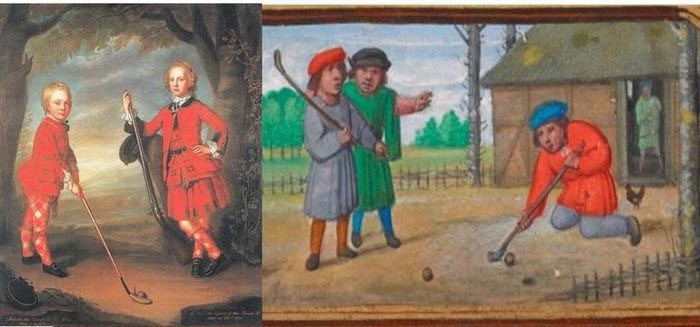Golf is a popular competitive sport that generates significant polarization among sports fans.
Supporters view it as a pinnacle of precision, while detractors consider it a dull game involving expensive clubs. However, few are aware that the history of this sport is as diverse and complex as its shots.
Where Did It All Begin?

Playing golf in ancient times.
Like many other popular sports, the origins of golf are a topic of much debate. Scotland, the Netherlands, and several other European countries all claim to be the birthplace of the game. According to historical documents, as early as 1261, people in the Netherlands played a game using sticks to hit balls into holes.
In the book Boeck Merlijn by Flemish poet Jacob van Maerlant (1235 – 1291), he describes the Dutch game “mit ener coluen”, which involved the use of a stick called “colf” or “kolf” to hit a ball. Over the centuries, these terms have been referenced many times.
In 1389, the city of Haarlem (Netherlands) was officially granted a colf course (the first of its kind). This sport even made its way to the New World. In December 1650, Dutch settlers at Fort Orange (now Albany, New York) played kolf for the first time on American soil.
The game became so popular that by 1659, colonial authorities had to issue a decree prohibiting people from playing kolf in the streets to avoid endangering pedestrians.
This indicates that kolf served as a precursor to modern golf and has existed for centuries. However, some believe that golf originated when Scottish shepherds, looking for ways to pass the time, used crude sticks to hit at rabbit holes. Over time, these activities evolved into a more organized game.
A significant milestone in golf history is attributed to King James II of Scotland. In 1457, he issued a royal decree banning golf and football, as they were deemed distractions from archery practice. Ironically, this decree helped draw more attention to the sport, as enthusiasts continued to play golf secretly.
In 1471 and 1491, stricter laws were enacted, further prohibiting golf as it was considered “not beneficial.” Despite continuously receiving sets of clubs and balls during visits to Perth, St Andrews, and Edinburgh, King James IV of Scotland upheld these bans.
Evolution Through the Ages
Early golfers used wooden clubs or mallets, often referred to as “feather clubs,” to hit leather balls stuffed with feathers. These early clubs lacked the precision of modern golf clubs. Golf courses were virtually nonexistent.
Golfers had to play on vast terrains with uneven ground, striving to get the ball as close to the target as possible with the fewest strokes. In those early days, people typically played this game on streets and in colder climates, even playing on ice.

Golf is becoming more popular.
As golf gained popularity, there arose a need to standardize the rules. The first international golf competition is believed to have occurred in 1681, when King James VII of Scotland competed against two English courtiers.
The earliest signs of standardization can be found in the writings of Thomas Kincaid, a medical student at the University of Edinburgh. In his 1687 diary, he wrote about the initial handicap system, noted the rules to be followed, and described his handicap stroke.
The oldest “official rules” date back to 1744, currently preserved at the National Library of Scotland, serving as a foundation for later rule books. Notably, rules such as “The tee must be on the ground” and “Do not change the ball that has been struck from the teeing ground.”
The 19th century witnessed the expansion of golf beyond Scotland’s borders, with golf courses springing up in England and other countries. This era also saw innovations in equipment, including the transition from feather balls to more durable gutta-percha balls and the development of clubs with iron heads.
Unlike many other sports, not everyone can afford to play golf, as it can be quite costly; equipment is not cheap, and club memberships have become a lucrative industry. The enduring appeal of golf lies in its ability to connect generations and cultures, fostering friendship and competition.
It is a sport that challenges traditions while celebrating its roots, proving that even the oldest pastimes can delight us with modern twists.
The most significant transformation in golf history occurred in the 20th century with the advent of television. Broadcasting major tournaments like The Masters and The Open Championship brought the sport to a global audience, contributing to its increasing popularity. Golfers such as Arnold Palmer, Jack Nicklaus, and Tiger Woods have become household names among fans of the game.


















































